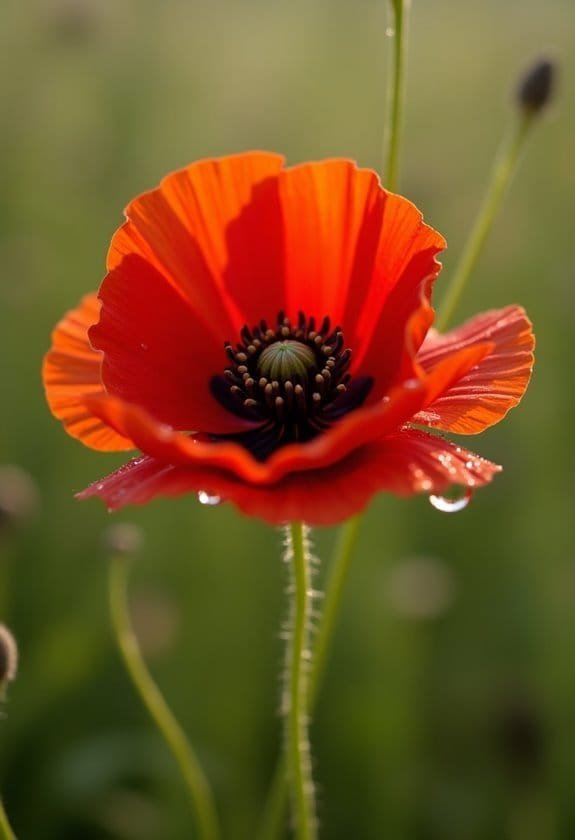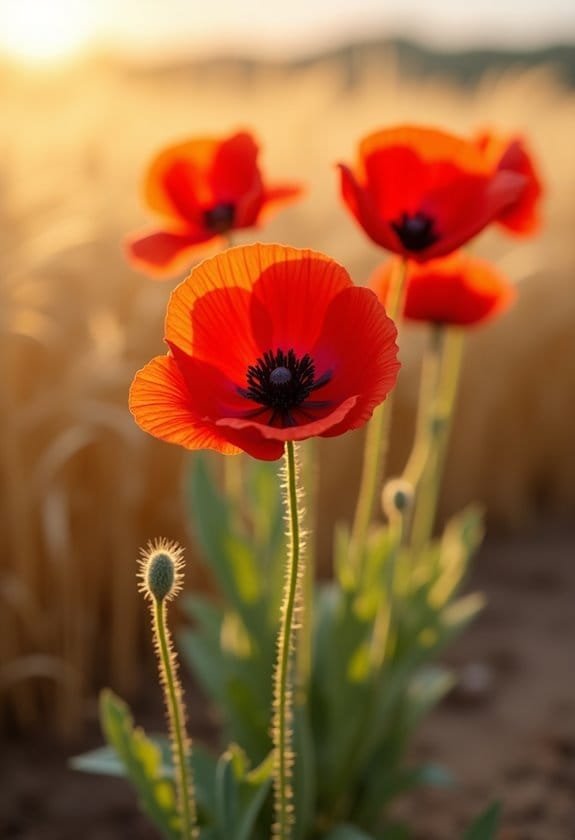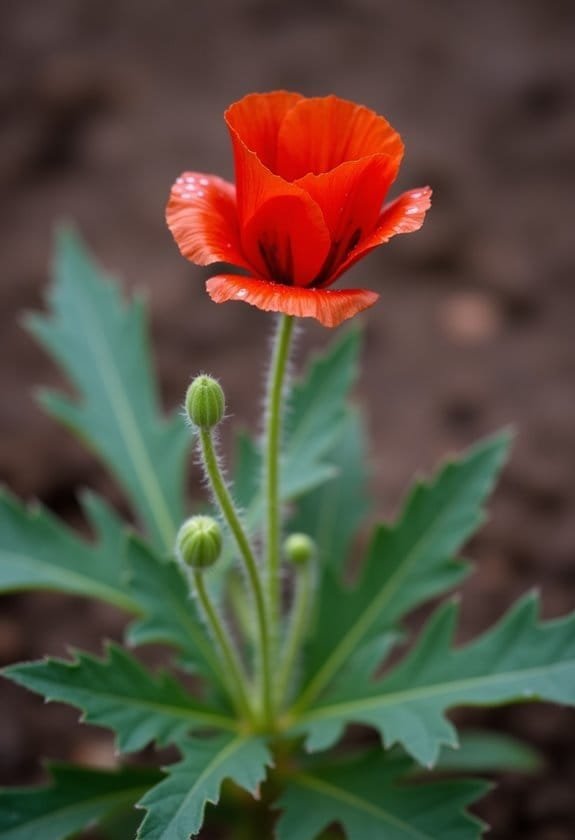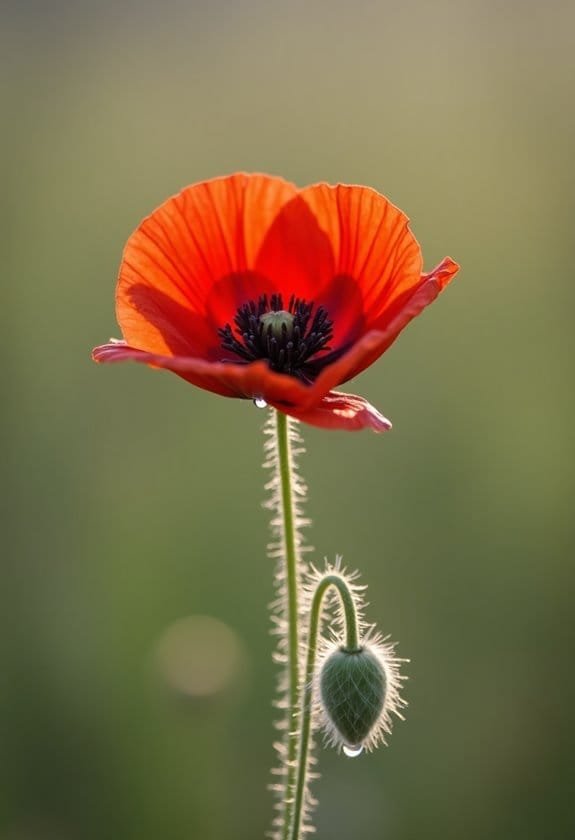Papaver rhoeas, commonly known as the corn poppy or Flanders poppy, is a striking wildflower that grows up to 70 cm tall with vibrant crimson blooms measuring 5-10 cm in diameter. It's become a powerful symbol of remembrance for fallen soldiers, particularly after World War I. The plant thrives in well-drained soils and full sun, flowering from late spring through early summer with delicate petals that last just one day. Its self-seeding nature and attraction to pollinators like bees and butterflies make it an excellent choice for meadow gardens and naturalized landscapes. This resilient beauty holds even more fascinating secrets beneath its scarlet surface.
Main Points
- Papaver rhoeas is a crimson-flowered annual plant growing up to 70 cm tall, commonly known as the Corn Poppy or Flanders Poppy.
- The flowers bloom from late spring to early summer, lasting only one day but producing abundant blossoms that attract pollinators.
- It symbolizes remembrance for fallen soldiers, particularly from World War I, where it grew abundantly in the battlefields of Flanders.
- The plant thrives in well-drained soils with full sun exposure and self-seeds readily, making it excellent for naturalized gardens.
- Common challenges include pests like aphids and diseases such as gray mold, though the plant generally requires minimal maintenance.
Introduction

Papaver rhoeas, commonly known as the Corn Poppy or Flanders Poppy, stands as one of Europe's most recognizable wildflowers with its striking crimson blooms.
The species belongs to the Papaveraceae family and thrives in agricultural landscapes, where its brilliant red petals and distinctive black basal spots create stunning natural displays.
Growing up to 70 centimeters tall, this annual herb has earned both ornamental acclaim and profound cultural significance, particularly as a symbol of remembrance for fallen soldiers following World War I.
Common Name
Recognition of this iconic flower spans continents and cultures through its various common names, including Flanders Poppy, Corn Poppy, Field Poppy, and Red Poppy. These diverse appellations reflect not only the plant's widespread distribution but also its profound cultural and historical significance across different regions.
The name "Corn Poppy" emerged from the species' tendency to flourish among cereal crops, where disturbed soil conditions create ideal growing environments for this adaptable plant.
Perhaps most poignantly, the designation "Flanders Poppy" carries deep historical resonance, commemorating the flower's prominent presence across World War I battlefields in the Flanders region. This association has transformed the common poppy into a powerful symbol of remembrance for fallen soldiers.
The scientific name, Papaver rhoeas (pronounced "puh-PAY-ver ROH-ee-as"), provides a standardized reference point for botanical communication, while its most straightforward descriptor, "Red Poppy," derives from its striking crimson petals and distinctive black center, which make it instantly recognizable in both agricultural and natural landscapes.
Scientific Name
Beyond its evocative common names, the scientific classification provides a precise taxonomic identity for this beloved flower. The species Papaver rhoeas, officially described by Carl Linnaeus in 1753, belongs to the broader family Papaveraceae, which encompasses various poppy species worldwide.
The nomenclature of these striking red poppies carries significant etymological meaning, reflecting both historical and botanical understanding. The genus name "Papaver" stems from Latin origins, directly translating to "poppy," while the species epithet "rhoeas" draws from Greek terminology, specifically referencing its identity as a corn poppy.
This scientific designation perfectly captures the plant's distinctive characteristics, including its impressive flowers measuring 5-10 centimeters in diameter, adorned with characteristic black spots at each petal's base. The formal classification has proven invaluable for botanical research, particularly in studying the species' remarkable ability to establish persistent seed banks in disturbed soils.
This adaptation has enabled Papaver rhoeas to maintain its presence across vast geographic regions, from European fields to the temperate zones of Asia and Africa.
Overview
The iconic corn poppy, Papaver rhoeas, stands as one of Europe's most recognizable wildflowers, distinguished by its vibrant red petals and distinctive black basal spots. This resilient annual herb reaches impressive heights of up to 70 centimeters, commanding attention in agricultural landscapes and disturbed soils throughout Africa, temperate Asia, and Europe.
The plant's remarkable adaptability to various environments has contributed to its widespread distribution, with corn poppies flourishing particularly well in sun-drenched, well-drained locations. From late spring through early autumn, their brilliant red flowers create stunning natural displays, transforming fields and roadsides into seas of crimson.
Beyond their aesthetic appeal, these striking blooms carry profound historical significance, having become powerful symbols of remembrance for fallen soldiers since World War I.
The species also offers practical value through its medicinal properties, containing alkaloids such as rhoeadine that possess mild sedative effects. Additionally, the plant's seeds serve culinary purposes, finding their way into various baked goods and contributing to oil production, demonstrating the versatility of this remarkable species in both cultural and practical applications.
Key Features
Papaver rhoeas displays impressive growth characteristics, reaching heights of up to 70 cm with hairy stems that support its distinctive blooms.
The plant's most striking feature is its large, vivid red flowers, which measure 5-10 cm across and showcase prominent black spots at their base, creating a dramatic contrast against the modest foliage.
These eye-catching blossoms emerge during late spring and early summer, with occasional autumn appearances, making the Corn Poppy a reliable source of color throughout multiple growing seasons.
Growth Size
Standing up to 90 centimeters (36 inches) in height, common poppies create striking displays with their bushy growth pattern and widespread presence. This herbaceous species exhibits an upright growth habit, forming substantial clumps that extend 15 to 30 centimeters (6 to 12 inches) in width, making them ideal for naturalized garden settings.
The plant's architectural presence is enhanced by its erect, hair-covered stems, which support impressive flowers measuring 5 to 10 centimeters (2 to 4 inches) in diameter. These blooms, with their characteristic bright red petals and occasional black basal markings, stand prominently above the foliage, commanding attention in any landscape arrangement they grace.
In favorable conditions, Papaver rhoeas demonstrates remarkable colonizing abilities through self-seeding, particularly in disturbed soils. This natural propagation tendency allows the species to establish enduring populations, especially in agricultural settings where soil disturbance is common.
The plant's moderate spread and manageable height make it an excellent choice for both planned gardens and naturalized meadow environments, where its structural form can be fully appreciated.
Appearance
Renowned for its striking appearance, Papaver rhoeas showcases vibrant red flowers with distinctive black basal spots that measure 5-10 centimeters across. These eye-catching blooms stand prominently atop hairy stems that rise gracefully to heights of 70 centimeters, creating a spectacular display in natural settings.
The poppy's most enchanting feature is its large, showy petals, which display an intense vivid red coloration that catches attention from considerable distances. During their peak blooming period from late spring to early summer, these delicate flowers create waves of crimson across meadows and fields, occasionally offering encore performances in autumn.
The plant's reproductive structure includes a smooth, obovoid capsule crowned by a stigma that matches or exceeds the capsule's width.
In contrast to its dramatic flowers, the plant's foliage maintains a modest presence, allowing the bold blooms to command attention. This natural arrangement emphasizes the poppy's most striking characteristic – its vibrant red petals – which have made it an iconic symbol in both horticultural and cultural contexts throughout history.
Flowering Season
Throughout late spring and early summer, fields and meadows come alive with the vibrant blooms of the corn poppy, creating a spectacular display that typically peaks between May and July. This resilient flowering plant demonstrates a remarkable reproductive strategy, with each individual bloom lasting just a single day before fading.
Despite the brief lifespan of individual flowers, the plant compensates by producing numerous blooms in succession throughout its flowering period, which can extend into autumn under favorable conditions.
The prolific nature of Papaver rhoeas guarantees a continuous display of its characteristic red petals, which measure an impressive 5 to 10 centimeters in diameter. In late spring, when the plants begin their flowering cycle, they establish themselves mainly in disturbed soils and agricultural settings, where their presence can transform ordinary landscapes into seas of crimson.
The species' self-seeding capability guarantees its return in subsequent seasons, maintaining its presence in suitable habitats year after year. This natural propagation method contributes to the plant's widespread distribution and its ability to create recurring seasonal displays.
Growing Requirements

Papaver rhoeas exhibits specific growing requirements that mirror its natural Mediterranean habitat, thriving in well-drained soils with full sun to partial shade exposure.
The plant's seeds need soil temperatures between 60°F and 70°F for ideal germination, which typically occurs when sown at the surface during late fall in southern regions or early spring in northern areas.
While these poppies prove relatively low-maintenance, they benefit from consistent moisture during dry spells and respond well to deadheading, which extends their blooming period from March through July.
Light
Bright, direct sunlight is vital for growing healthy Papaver rhoeas plants. These vibrant poppies require a minimum of 6-8 hours of full sun exposure daily to achieve their characteristic brilliant blooms and robust growth patterns.
While they demonstrate some adaptability to varying light conditions, their performance in partially shaded locations often results in diminished flowering and less intense coloration.
The relationship between light exposure and soil moisture becomes particularly significant during the growing season. In full sun conditions, gardeners must maintain consistent soil hydration to compensate for increased evaporation rates, especially during prolonged dry spells.
The intensity of sunlight also influences soil temperature, which plays an important role in seed germination. Ideal growing conditions emerge when soil temperatures reach between 60°F and 70°F, creating an environment where seeds can successfully sprout and develop into healthy specimens.
While these poppies can establish themselves in various light environments, their true potential manifests in locations that receive abundant direct sunlight, where they'll reward gardeners with prolific blooms and the richest possible color display.
Soil
Successful cultivation of corn poppies depends heavily on well-drained, fertile soil conditions. These adaptable plants thrive in nutrient-rich environments that support their rapid growth cycle and abundant flowering potential, making soil quality a significant factor in their development.
The soil temperature plays an important role in the germination process, with ideal ranges between 60°F and 70°F creating perfect conditions for seed sprouting. Curiously, Papaver rhoeas exhibits a distinctive characteristic where soil disturbance actively promotes germination, explaining their frequent appearance in freshly tilled agricultural fields and along recently disturbed roadsides. This natural adaptation has earned them recognition as agricultural companions throughout history.
Maintaining proper soil moisture through regular watering proves fundamental, particularly during dry periods when the plants are establishing themselves or preparing to bloom.
While these poppies demonstrate remarkable resilience, their preference for well-structured soils can't be overlooked. Gardeners should guarantee adequate drainage while retaining enough moisture to support healthy growth, creating a balance that mimics the plant's natural habitat conditions.
Water
Water management plays an essential role in growing healthy corn poppies, requiring a delicate balance between adequate moisture and proper drainage. During the critical germination period, which spans 10 to 30 days, maintaining consistent soil moisture proves essential for successful seedling development and establishment.
While Papaver rhoeas demonstrates some resilience to drought conditions, regular watering practices greatly enhance its growth potential and flowering performance. The plant's root system requires careful attention to prevent oversaturation, as excessive moisture can lead to devastating root rot issues.
Gardeners should allow the soil's surface to dry slightly between watering sessions, creating ideal conditions for root health and nutrient uptake. During periods of intense summer heat, these striking wildflowers may require additional watering to maintain their vibrant appearance and sustain healthy growth patterns.
The key lies in providing supplemental moisture while ensuring the soil maintains its well-draining characteristics. For best results, watering should be adjusted according to environmental conditions, with particular attention paid during the plant's active growing phase when it receives full sun exposure of at least six hours daily.
Temperature
The ideal temperature range for Papaver rhoeas spans between 60°F to 70°F (15°C to 21°C), creating favorable conditions for both germination and sustained growth. Like a well-calibrated thermometer, these delicate flowers respond precisely to their environmental conditions, thriving in temperate climates that provide consistent thermal stability.
While ideal germination occurs within this moderate temperature band, Papaver rhoeas demonstrates remarkable resilience across broader temperature variations. These adaptable plants maintain their liveliness in USDA Zones 8-10, weathering winter temperatures as low as 10°F (−12°C) without significant damage to their root systems.
During the growing season, full sun exposure becomes essential for maintaining appropriate soil temperatures and supporting robust development.
Temperature management becomes particularly important during seasonal changes, when fluctuations can impact blooming patterns and overall plant vigor. Gardeners should monitor local weather patterns and provide appropriate protection during extreme temperature events, especially in regions prone to sudden thermal shifts.
The plant's temperature requirements align seamlessly with its Mediterranean origins, where moderate climates historically shaped its evolutionary adaptations.
Pollinator Criteria
The Common Poppy serves as a crucial nectar and pollen source for numerous pollinator species, particularly bees and butterflies drawn to its striking crimson blooms.
During its peak flowering period from late spring through early summer, the plant's robust structure, featuring tall stems and accessible flowers, creates an ideal feeding station for these important insects.
The abundance of nutritious resources, combined with the poppy's widespread distribution in meadows and disturbed areas, makes it an essential contributor to pollinator health and ecosystem stability.
Attracted Pollinators
Throughout its blooming period from late spring to early summer, Papaver rhoeas attracts numerous pollinator species with its striking red flowers that can reach up to 10 cm in diameter. These vibrant blooms serve as natural beacons for various insects, particularly bees and butterflies, which are inherently drawn to their rich coloration and accessible nectar resources.
The common poppy's strategic presence in disturbed soils and agricultural landscapes creates essential feeding stations for diverse pollinator populations. Like nature's own roadside restaurants, these flowers provide necessary sustenance during critical foraging periods when many pollinators are most active.
The plant's adaptability to various environments has made it an invaluable contributor to local ecosystem health and biodiversity.
The relationship between P. rhoeas and its pollinators exemplifies a mutually beneficial arrangement within meadow ecosystems. As these insects move from flower to flower, they facilitate cross-pollination while securing their own nutritional needs, demonstrating the intricate connections that maintain healthy pollinator communities.
This ecological service becomes particularly significant in agricultural areas, where the presence of natural pollinators can enhance crop production and support sustainable farming practices.
Pollination Method
Successfully pollinating Papaver rhoeas flowers requires precise timing and specific insect behavior, as each bloom remains open for just one day during the late spring to early summer season.
The red corn poppy has evolved a sophisticated pollination mechanism that maximizes its reproductive success through strategic adaptations.
The flower's distinctive morphological features play essential roles in facilitating effective pollination. Its large, crimson petals serve as conspicuous visual signals to passing pollinators, while the flower's broad, flat surface provides an ideal landing platform for visiting insects.
Bees and butterflies, the primary pollinators, are particularly drawn to these striking blooms, where they encounter abundant nectar and pollen rewards.
This intricate pollination process contributes notably to the genetic diversity of Papaver rhoeas populations. As insects move between different plants, they facilitate cross-pollination, transferring pollen from one flower to another.
The resulting genetic variation enhances the species' adaptability and resilience in various environmental conditions, ensuring its continued survival across different habitats.
Care & Maintenance

Papaver rhoeas thrives with minimal intervention when gardeners follow essential planting strategies, including selecting well-drained locations with full sun exposure and sowing seeds directly in disturbed soil during early spring or fall.
The plant's ongoing maintenance requirements remain straightforward, focusing primarily on consistent watering during establishment and occasional deadheading to extend the blooming period.
These hardy poppies partner particularly well with complementary species such as Centaurea cyanus (cornflower) and Matricaria chamomilla (chamomile), which share similar growing conditions and create stunning meadow-like displays.
Planting Tips
For ideal growth and flowering, the common poppy requires minimal but specific care during its growing season. Success with these delicate yet resilient poppies begins with proper soil preparation and timing, as these factors greatly influence germination rates and overall plant health.
When planting Papaver rhoeas, gardeners should select well-draining soil in locations that receive abundant sunlight throughout the day. The seeds should be scattered directly on the soil surface rather than buried, as they need light to trigger germination effectively.
While early spring provides excellent growing conditions, experienced gardeners often opt for fall planting, which allows seeds to naturally stratify during winter months.
The plant's preference for disturbed soil makes it particularly adaptable to various garden settings, from formal beds to naturalized meadows. When establishing new poppy patches, maintain consistent soil moisture until seedlings emerge, but avoid oversaturating the growing area.
Strategic placement in rich, well-worked soil eliminates the need for supplemental fertilization, allowing these hardy annuals to flourish with minimal intervention while creating stunning seasonal displays.
Ongoing Care
Once established in well-prepared soil, Papaver rhoeas requires minimal yet specific ongoing care to thrive throughout its growing season. The plant's adaptability to various soil types makes it remarkably self-sufficient, though attentive maintenance can greatly enhance its flowering performance.
Regular deadheading stands as the cornerstone of ongoing care, encouraging the development of additional blooms and extending the flowering period well into the season.
While these poppies demonstrate admirable drought tolerance once established, supplemental watering during extended dry spells helps maintain their vigor and blooming capacity.
The plant's natural propensity for self-seeding presents an opportunity for sustainable garden management. By strategically allowing some flowers to complete their lifecycle and disperse seeds at season's end, gardeners can guarantee continued presence in subsequent years.
This characteristic, combined with the plant's inherent resistance to deer browsing, makes it an ideal candidate for low-maintenance landscapes.
Despite its hardy nature, monitoring soil moisture levels and avoiding waterlogged conditions remains essential for ideal growth and sustained flowering performance.
Suggested Companions
When planning a companion garden for Papaver rhoeas, selecting plants that share similar growing requirements while offering complementary visual elements creates a harmonious and sustainable landscape. The combination of soil preferences and sunlight needs plays a significant role in successful companion planting strategies.
Cornflowers and daisies make excellent companions, as they thrive under similar conditions and create a stunning visual display alongside the vibrant red poppies.
Ground-covering plants like creeping thyme serve a dual purpose by suppressing unwanted weeds while providing textural contrast to the poppies' upright stems.
For gardeners focused on water conservation, drought-tolerant lavender proves to be an ideal companion, sharing the poppies' preference for well-drained soil conditions.
To enhance the garden's ecological value, flowering herbs such as basil and chives attract beneficial pollinators while adding practical value to the planting scheme.
The self-seeding nature of Papaver rhoeas works particularly well when paired with statuesque snapdragons, which provide vertical interest and create an enchanting backdrop that evolves naturally throughout the growing season.
Common Issues
Common poppies face several significant challenges from both pests and diseases that can compromise their health and energy.
Botrytis cinerea, commonly known as gray mold, and powdery mildew tend to flourish in humid conditions, while aphids and slugs can wreak havoc on the plant's foliage and overall development.
Gardeners can combat these issues through proper spacing to improve air circulation, maintaining well-drained soil conditions, and implementing integrated pest management strategies such as introducing beneficial insects or applying organic fungicides when necessary.
Pests/Diseases
Despite its hardy nature, Papaver rhoeas faces several pest and disease challenges that can impact its health and appearance.
Aphids pose a considerable threat to these delicate blooms, causing leaves to curl and stunting overall growth patterns when colonies establish themselves on the plant. Additionally, fungal diseases, particularly powdery mildew, can spread rapidly across foliage during humid conditions, manifesting as distinctive white, powder-like patches on leaf surfaces.
The plant's susceptibility to root rot becomes particularly evident in poorly draining soils, where excessive moisture creates an environment conducive to pathogenic activity below ground.
Moth caterpillars present another concerning challenge, as these voracious feeders can systematically defoliate both leaves and flowers, potentially compromising the plant's ability to complete its growth cycle.
Fortunately, gardeners can implement various preventive measures to protect their poppies, including regular monitoring for early signs of infestation, maintaining proper spacing between plants to improve air circulation, and implementing strategic crop rotation practices.
These cultural controls, combined with appropriate watering techniques, greatly reduce the risk of pest and disease problems.
Solutions
Successfully managing Papaver rhoeas involves addressing several common cultivation challenges through straightforward solutions.
The first critical step is ensuring proper soil drainage, which can be achieved by incorporating organic matter or coarse sand into heavy soils to prevent devastating root rot issues.
To maintain healthy plant populations, gardeners should implement regular monitoring of self-sowing patterns and thin out seedlings when they become too dense. A spacing of 6-8 inches between plants typically provides ideal growing conditions and reduces competition for essential nutrients and water resources.
When it comes to maximizing bloom duration, implementing a consistent deadheading schedule removes spent flowers before they set seed, redirecting the plant's energy into producing new blooms.
In areas where livestock may graze, installing protective fencing or choosing alternative planting locations helps prevent potential toxicity issues.
For regions where these poppies display invasive tendencies, establishing designated growing areas with physical barriers and implementing strict seed head removal practices can effectively control their spread while still allowing for their ornamental benefits.
Summary

The vivid red Papaver rhoeas, widely known as the Corn Poppy or Flanders Poppy, stands as a significant plant species in both ecological and cultural contexts. This remarkable annual herb, growing up to 70 cm tall, has established itself as a resilient presence across Europe and Asia's diverse landscapes, particularly thriving in disturbed soils and agricultural settings.
The Flanders Poppy's importance extends far beyond its striking appearance, as it serves multiple essential roles in both natural and human systems. Its alkaloid content, specifically rhoeadine, provides mild sedative properties, while its edible seeds contribute to culinary traditions worldwide.
The Corn Poppy has become deeply intertwined with human history, especially as a powerful symbol of remembrance for fallen soldiers since World War I, immortalized in the poem "In Flanders Fields."
From an ecological perspective, these hardy plants serve as excellent indicators of environmental health and provide crucial support for pollinators. Their self-sowing capability and minimal maintenance requirements make them ideal candidates for garden naturalization, offering both aesthetic appeal and ecological benefits to cultivated spaces.


